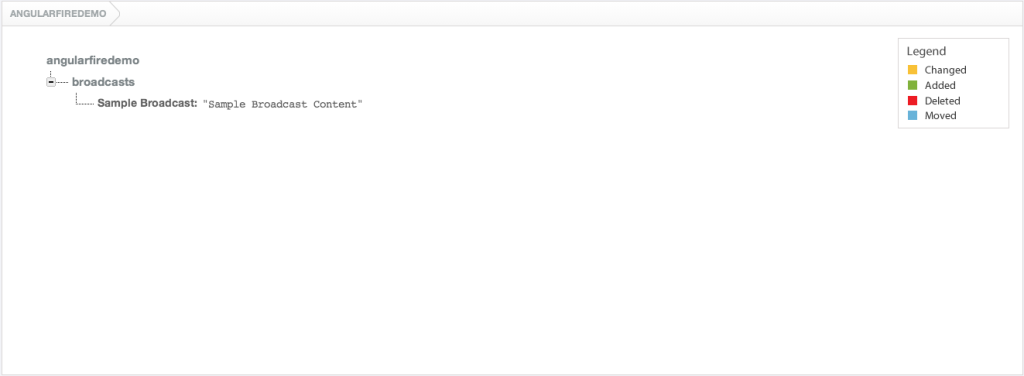As you may know, FireBase acts as a realtime backend for your apps. Well, we all know how awesome this is. But you know what’s more awesome? It’s AngularJS+FireBase. FireBase has an officially released binding called AngularFire that brings all the fun and joy of FireBase to AngularJS. As AngularJS developers we love data binding so much that we even dream about it! With AngularFire we can create some seriously awesome stuff by taking advantage of a three way data binding as opposed to the traditional two way data binding in AngularJS. This tutorial will give you an overview of three way binding while creating a simple realtime app using AngularFire. This article assumes that the reader is already aware of FireBase and has done some prior development in AngularJS.
What’s Three Way Data Binding
In AngularJS our scope model and view stay in sync thanks to the two way data binding. But if you introduce AngularFire, and thereby use FireBase as a backend, you empower yourself with a three way binding feature. You can basically bind your model data to a FireBase location so that whenever your models change, those changes are automatically pushed to FireBase. Similarly, whenever the data at the particular FireBase location changes, your local scope model is also updated. And, since our view and scope model are already in sync, this creates a three way data binding. The obvious benefit is that it lets you create cool realtime apps where the data changes frequently and those modifications are broadcast to all the connected users. All this happens without any significant effort. If you are building a chat application, a multiplayer game app, or a broadcast system you can leverage this feature.Getting Started
To demonstrate the concept of three way binding, let’s create a sample application. Our application will be a realtime broadcast system where users can broadcast what they are typing in realtime. For each user there will be two options:- Start a broadcast
- View a broadcast
Basic Architecture
To start we need to find out how to store our broadcast data. First, login to FireBase and create a new FireBase storage. I created a FireBase calledangularfiredemo, and hence we will be using the URL https://angularfiredemo.firebaseio.com to store data. Note that each FireBase location is represented by a URL, and we can have multiple broadcasts to handle the many users that will be using our system. Let’s store all our broadcasts under the location https://angularfiredemo.firebaseio.com/broadcasts. Each broadcast has two parts: the name and the content, represented by key/value pairs. A sample broadcast data is stored as shown in the following image.
 To view a broadcast, users will need to choose a particular broadcast name represented by the key in our FireBase. The next step for us is to build an AngularJS app around these key points.
Those of you who are interested in the end product can checkout a demo at Plunker. To have a realtime experience, open two instances of your browser side by side. In the first instance, give your broadcast a name, start it, and then begin writing. In the second instance, choose the broadcast you just started from the dropdown menu. Now you can see the broadcast in realtime.
To view a broadcast, users will need to choose a particular broadcast name represented by the key in our FireBase. The next step for us is to build an AngularJS app around these key points.
Those of you who are interested in the end product can checkout a demo at Plunker. To have a realtime experience, open two instances of your browser side by side. In the first instance, give your broadcast a name, start it, and then begin writing. In the second instance, choose the broadcast you just started from the dropdown menu. Now you can see the broadcast in realtime.
Building the App
To get started we need the following scripts:AngularJS: The main AngularJS script.FireBase: The script for enabling FireBase support.AngularFire: FireBase binding for AngularJS.Angular Route: For routing support in AngularJS.Angular Sanitize: To sanitize incoming data from FireBase.
Step 1
The first step is creating our main app module which is done like this:angular.module('firebaseDemo', ['firebase', 'ngSanitize', 'ngRoute']);
angular.module('firebaseDemo').constant('FIREBASE_URL','https://angularfiredemo.firebaseio.com/broadcasts');firebase,ngSanitize, and ngRoute. All of the AngularFire functionality is encapsulated in its own module, firebase. ngSanitize and ngRoute are used for sanitizing the data and routing support respectively. We have also defined a constant, FIREBASE_URL, which reprsents the location that stores all the broadcasts.
Step 2
Now, let’s create a factory that retrieves the broadcasts from FireBase.angular.module('firebaseDemo').factory('broadcastFactory', function($firebase,FIREBASE_URL) {
return {
getBroadcast: function(key) {
return $firebase(new Firebase(FIREBASE_URL + '/' + key));
},
getAllBroadcasts: function() {
return $firebase(new Firebase(FIREBASE_URL));
}
};
});broadcastFactory declares a dependency on FIREBASE_URL, which represents the location of our broadcasts. Our factory also depends on an AngularFire service called $firebase. It accepts a FireBase object and returns a special object which is kept in sync with the remote FireBase location. It has functions like $add(), $set(), $child(), etc. to work with data. Whenever an update is made to this local object, the change is pushed to the remote FireBase location.
The factory has two functions:
getBroadcast(key): This returns a single object that represents a broadcast. This object has a property called$valuewhich represents the content for the broadcast. We use this object to create a three way binding so that whatever the user types is constantly in sync with the remote FireBase location.getBroadcasts(): This function returns an object that has all the broadcasts as its properties. We present this data to the users so that they can choose a broadcast to view.
Step 3
The next step is creating our main view inindex.html:
<!DOCTYPE html>
<html ng-app="firebaseDemo">
<head>
<meta charset="utf-8" />
<title>AngularFire Demo</title>
<link rel="stylesheet" href="style.css" />
<link rel="stylesheet" href="//netdna.bootstrapcdn.com/bootstrap/3.1.1/css/bootstrap.min.css" />
<script src="https://ajax.googleapis.com/ajax/libs/angularjs/1.2.16/angular.min.js" data-semver="1.2.16"></script>
<script src="https://code.angularjs.org/1.2.16/angular-sanitize.js" data-semver="1.2.16"></script>
<script src="https://code.angularjs.org/1.2.16/angular-route.js" data-semver="1.2.16"></script>
<script src="https://cdn.firebase.com/js/client/1.0.6/firebase.js"></script>
<script src="https://cdn.firebase.com/libs/angularfire/0.7.1/angularfire.min.js"></script>
<script src="app.js"></script>
</head>
<body>
<div class="container"> <br/>
<div class="row">
<div class="col-xs-5 col-xs-offset-1 text-right">
<a class="btn btn-lg btn-primary" href="/write">Write Something</a>
</div>
<div class="col-xs-5 text-left">
<a class="btn btn-lg btn-success" href="/view">View a Broadcast</a>
</div>
</div>
<div ng-view></div>
</div>
</body>
</html>Write Something: Loads a new AngularJS route that lets users to start a broadcast.View a Broadcast: Loads an AngularJS route that allows users to view a broadcast.
ng-view directive where different routes will be loaded. All our AngularJS code is present in app.js.
Note: Any serious AngularJS app should consider modularizing the code either by layers or features. For this simple app I have put all the AngularJS components like controllers and directives in a single file, app.js. But this is certainly not the way to go for large scale AngularJS apps.
Step 4
Next, create two different views: one for broadcasting and another for viewing. We will also configure the routes by using$routeProvider. The following code is taken from views/write.html.
<hr/>
<div class="row">
<div class="col-xs-4 col-xs-offset-3">
<input type="text" class="form-control input-lg" ng-model="broadcastName" placeholder="Type your broadcast name here" />
</div>
<div class="col-xs-5">
<button class="btn btn-lg btn-success" ng-click="startBroadcast()" ng-disabled='isButtonEnabled()'>Start</button>
</div>
</div>
<h1 class="text-center">Write Something. . .</h1>
<div class="row">
<div class="col-xs-8 col-xs-offset-2">
<div id="editor" demo-editor model="broadcast" class="well">
</div>
</div>
</div><div id="editor" demo-editor></div>. The demoEditor is a custom directive which will be shown next.
The corresponding controller associated with this view is:
angular.module('firebaseDemo').controller('BroadcastController', function($scope, broadcastFactory) {
$scope.isEditable = false;
$scope.broadcastName = '';
$scope.isButtonEnabled = function() {
return ($scope.broadcastName === 'undefined') || ($scope.broadcastName.length < 1);
};
$scope.startBroadcast = function() {
$scope.isEditable = true;
$scope.broadcastFromFireBase = broadcastFactory.getBroadcast($scope.broadcastName);
$scope.broadcastFromFireBase.$set('');
$scope.broadcastFromFireBase.$bind($scope, 'broadcast');
};
});$scope and broadcastFactory. The isEditable scope model is used to indicate whether our editor is active. When a user clicks the Start button in our view, the editor becomes active and accepts inputs. Our view also contains a text field that is bound to the scope model, broadcastName. Before starting the broadcast we ask our users to give a name to the broadcast. The broadcast content will be stored against this key in our FireBase.
The isButtonEnabled() function is used to track if the broadcast name is empty. If so, then we disable the Start button. This function is used with the ng-disabled directive attached to the Start button.
The startBroadcast() function is used to initiate a broadcast. This function gets called when the Start button is clicked thanks to the ng-click directive. Inside this function, we set isEditable model to true, activating our editor. Next, we call the broadcastFactory.getBroadcast() function, passing broadcastName as a key. Then, we set an empty string at this location using $set(). This acts as the initial broadcast content. Note that this operation creates a new child under https://angularfiredemo.firebaseio.com/broadcasts. The name of this child is the same as the value of $scope.broadcastName. So, the location where our new broadcast will be stored is https://angularfiredemo.firebaseio.com/broadcasts/<broadcastName>. Note that the initial content of this location will be an empty string.
In the end we will perform the most crucial operation, which creates a three way binding. The operation $scope.broadcastFromFireBase.$bind($scope, 'broadcast'); does this. Because of this, the remote FireBase location stays in sync with our local scope model, broadcast. This local model is also bound to our editor. As a result whenever the user types something into the editor, the broadcast model is updated. And, due to three way binding, the remote FireBase content is also updated with this new broadcast content.
Now, let’s move to our next view, which exists in views/view.html.
<h1 class="text-center">Live Broadcast</h1>
<div class="row">
<div class="col-xs-4 col-xs-offset-4">
<select ng-model="broadcastToView" ng-change="broadcastSelected()" class="form-control" ng-options="k as k for (k, v) in broadcasts">
<option value="">{{dropdownMessage}}</option>
</select>
</div>
</div>
<div class="row">
<div class="col-xs-8 col-xs-offset-2">
<div id="editor" class="well" ng-bind-html="broadcast.$value">
</div>
</div>
</div>angular.module('firebaseDemo').controller('BroadcastViewerController', function($scope, broadcastFactory) {
$scope.dropdownMessage = 'Retrieving Broadcasts...';
$scope.broadcasts = broadcastFactory.getAllBroadcasts();
$scope.broadcastSelected = function() {
$scope.broadcast = broadcastFactory.getBroadcast($scope.broadcastToView);
}
$scope.broadcasts.$on('loaded', function() {
$scope.dropdownMessage = 'Select a broadcast';
});
});broadcastFactory.getAllBroadcasts(). Remember, this is a single object that contains all the children as properties. The property names are the broadcast names, while their values represent the broadcast content. These broadcast names are shown to the users in a dropdown so that they can choose a broadcast to view.
When the dropdown value changes due to a selection, the function broadcastSelected() is called. This function uses broadcastFactory.getBroadcast() to obtain the particular broadcast object. This object has a property called $value which represents the actual content. Finally, we bind this value to our div through ng-bind-html so that the user can see the broadcast in realtime. ng-bind-html is used because the FireBase location may also have HTML content. Because of this directive we included the ngSanitize module (to sanitize the data), without which the directive will throw an exception.
Also note that when the view is loaded, the FireBase data will not sync immediately. $scope.broadcasts will have the actual value after few seconds. So, until the data is synced from server, it’s good to show that we are retrieving the dropdown data. That’s why I have the model $scope.dropdownMessage which is used as the first <option> in the dropdown. When the data is actually synced from the server a loaded event is triggered, and we change the dropdownMessage value to Select a broadcast.
Step 5
We also have a custom directive,demoEditor, which converts a div into an editable div so that users can type into it. I know we could have gone with a simple textarea, but what if you wanted to give the users ability to write HTML? Maybe some kind of WYSIWYG editor? In that case we need a div, where users can type. Here is our directive definition:
angular.module('firebaseDemo').directive('demoEditor', function(broadcastFactory) {
return {
restrict: 'AE',
link: function(scope, elem, attrs) {
scope.$watch('isEditable', function(newValue) {
elem.attr('contenteditable', newValue);
});
elem.on('keyup keydown', function() {
scope.$apply(function() {
scope[attrs.model] = elem.html().trim();
});
});
}
};
});div is initially non-editable, and becomes editable when the user clicks Start. As this is a div element, you can not attach ng-model to sync its content to a model. So, we attach a keyup keydown listener to keep the scope model in sync with this div content. The scope model name (which we want to keep updated) is passed to the directive as an attribute. In case you missed it, the directive is used in the view like this:
<div id="editor" demo-editor model="broadcast" class="well"></div>model attribute specifies the scope model to keep in sync. Also note that this directive does not create a new scope. It uses the parent scope.
Step 6
Let’s configure the routes and enjoy the cool three way binding in action!angular.module('firebaseDemo').config(function($routeProvider, $locationProvider) {
$routeProvider.when('/write', {
controller: 'BroadcastController',
templateUrl: '/views/write.html'
}).when('/view', {
controller: 'BroadcastViewerController',
templateUrl: '/views/view.html'
}).otherwise({
redirectTo: '/write'
});
$locationProvider.html5Mode(true);
});Conclusion
I hope you enjoyed experimenting with AngularJS and FireBase. AngularJS, when combined with FireBase, can be used to create awesome apps that sync in realtime. I encourage you to go through the AngularFire documentation to know more about the API methods. Have a nice realtime!! The complete source code can be downloaded from GitHub.Frequently Asked Questions (FAQs) on Three-Way Data Binding with Firebase and AngularJS
What is the significance of three-way data binding in AngularJS?
Three-way data binding in AngularJS is a powerful feature that allows for real-time synchronization between the model, view, and the backend data source. This means that any changes made to the model are instantly reflected in the view and the backend, and vice versa. This eliminates the need for manual synchronization and makes the application more responsive and user-friendly. It is particularly useful in applications that require real-time data updates, such as chat applications, collaborative tools, and live dashboards.
How does Firebase facilitate three-way data binding in AngularJS?
Firebase is a cloud-based NoSQL database that provides APIs for data synchronization across multiple clients. When used with AngularJS, Firebase allows for three-way data binding through the AngularFire library. This library provides a $firebaseObject service that creates a synchronized object, and a $firebaseArray service that creates a synchronized array. These services automatically update the view and the Firebase database whenever the model changes, thereby enabling three-way data binding.
What are the steps to set up Firebase in an AngularJS application?
Setting up Firebase in an AngularJS application involves a few steps. First, you need to create a Firebase project through the Firebase console. Then, you need to add Firebase to your web app by including the Firebase and AngularFire scripts in your HTML file. After that, you need to initialize Firebase with your project’s configuration details. Finally, you need to inject the AngularFire services into your AngularJS application to enable three-way data binding.
How does the $watch function contribute to three-way data binding in AngularJS?
The $watch function in AngularJS is used to monitor changes in a model. In the context of three-way data binding, the $watch function is used to detect changes in the model and update the view and the Firebase database accordingly. This ensures that the view and the database always reflect the current state of the model.
What are the benefits and drawbacks of three-way data binding?
Three-way data binding offers several benefits. It simplifies the code by eliminating the need for manual synchronization between the model, view, and backend. It also makes the application more responsive and user-friendly by providing real-time updates. However, three-way data binding also has some drawbacks. It can lead to performance issues if not managed properly, as it involves constant data synchronization. It can also make the code more complex and harder to debug, as changes can come from multiple sources.
Can I use three-way data binding with other databases besides Firebase?
Yes, while Firebase provides built-in support for three-way data binding in AngularJS through the AngularFire library, it is possible to implement three-way data binding with other databases. However, this would require additional coding to synchronize the model, view, and database, as other databases do not provide the same level of integration with AngularJS as Firebase.
How can I handle errors in three-way data binding?
Error handling in three-way data binding can be done using AngularJS’s error handling mechanisms. For example, you can use the $error object to check for validation errors in the model. You can also use the $promise property of the $firebaseObject and $firebaseArray services to handle errors in data synchronization with Firebase.
How can I secure my Firebase database when using three-way data binding?
Firebase provides several security features to protect your data. You can use Firebase’s security rules to control who can read and write data to your database. You can also use Firebase Authentication to authenticate users and manage user sessions. It’s important to properly configure these security features to ensure that your data is protected.
Can I use three-way data binding in AngularJS without Firebase?
Yes, it is possible to implement three-way data binding in AngularJS without Firebase. However, this would require additional coding to synchronize the model, view, and backend, as AngularJS does not provide built-in support for three-way data binding.
What are some best practices for using three-way data binding in AngularJS?
Some best practices for using three-way data binding in AngularJS include: using the $firebaseObject and $firebaseArray services for data synchronization with Firebase; using the $watch function to monitor changes in the model; handling errors properly; securing your Firebase database; and managing performance by limiting the amount of data that is synchronized.
 Sandeep Panda
Sandeep PandaSandeep is the Co-Founder of Hashnode. He loves startups and web technologies.



